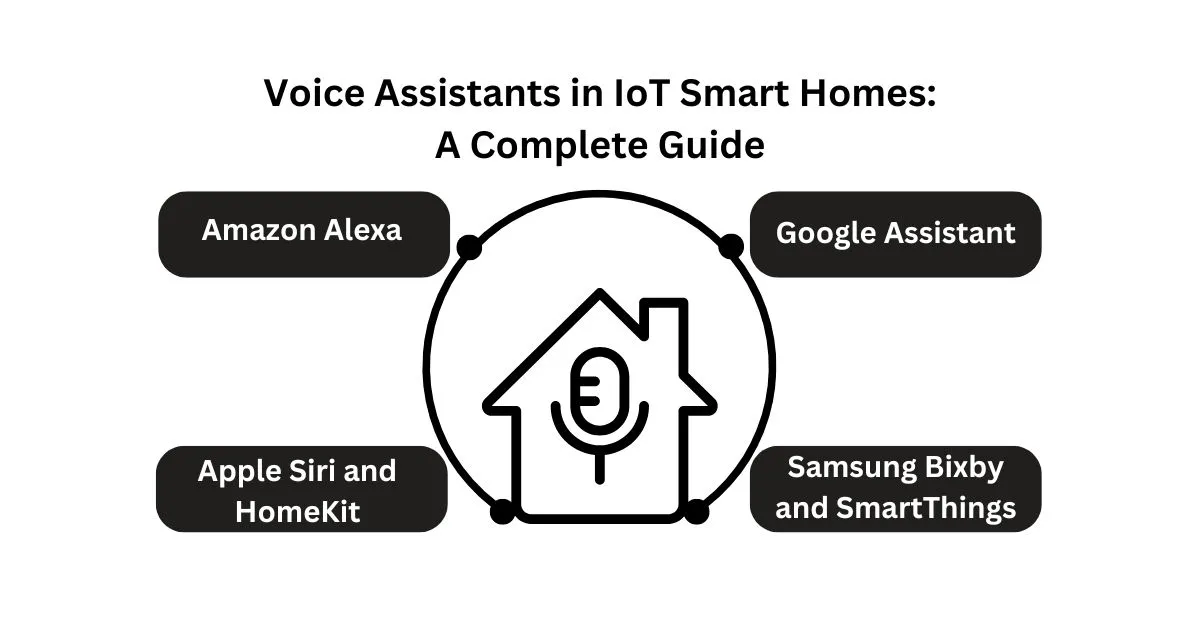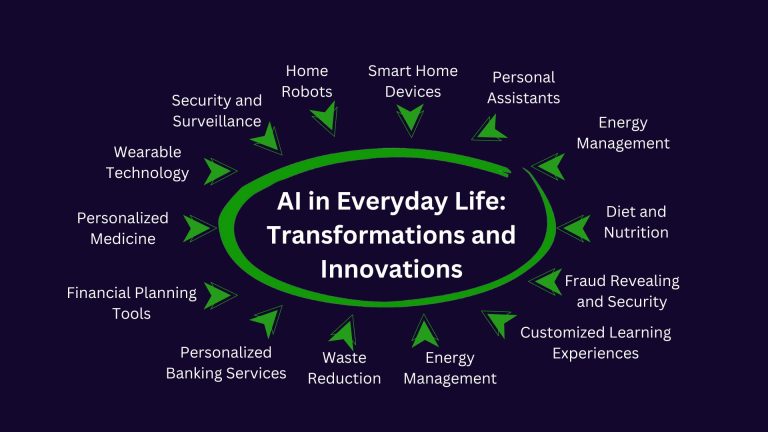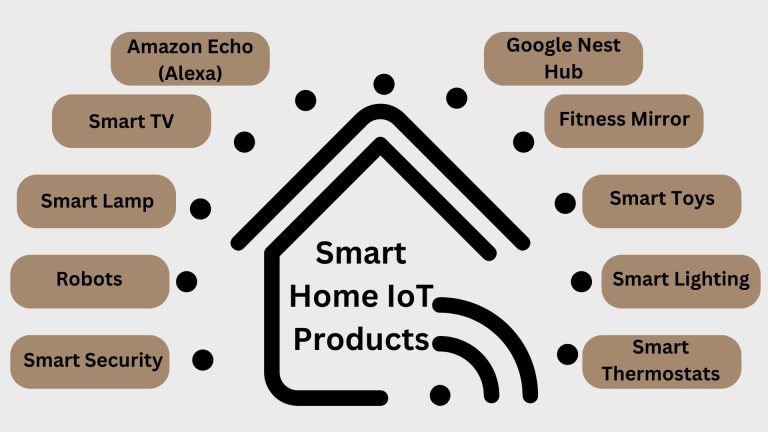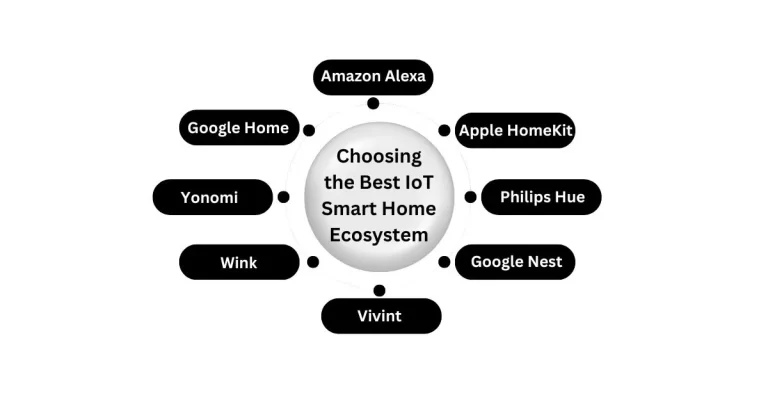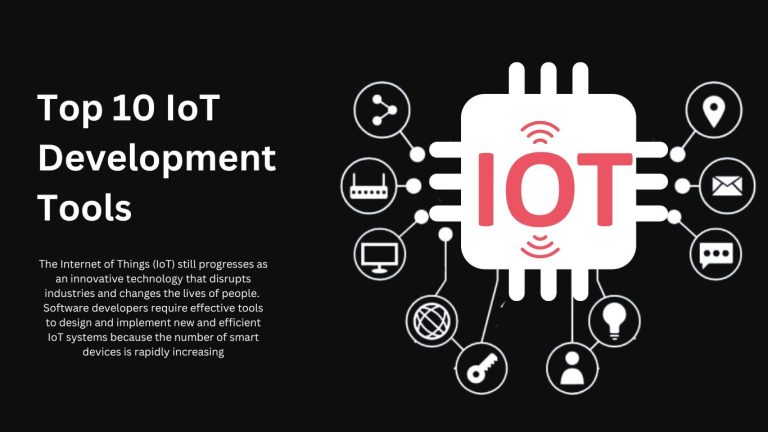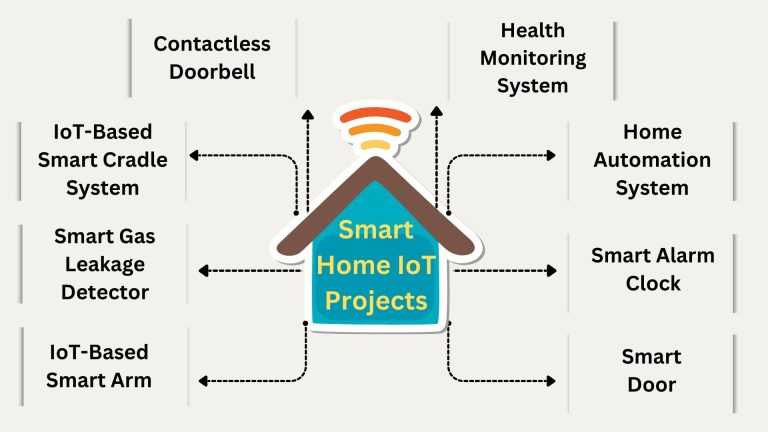Voice Assistants in IoT Smart Homes : A Complete Guide
Voice assistants are now a popular feature in modern smart homes. Voice Assistants in IoT Smart Homes are voice-controlled helpers that control most home amenities, including lighting, climate, security, home theater systems, etc. The use of voice assistants in IoT devices in smart homes has made it easy, natural, and effective for homeowners to manage their surroundings easily.
This complete blog guide explores voice assistants in IoT smart homes, the most-used platforms, features, and trends.
Introduction to Voice Assistants in IoT Smart Homes
Voice assistants in IoT smart homes are critical features of the contemporary smart home ecosystem. Powered by Artificial Intelligence, these voice-activated platforms enable users to accomplish a variety of tasks simply through voice commands. These are linked with millions of IoT products, including Amazon Alexa, Google Assistant, and Apple Siri, enabling users globally to manage their smart homes easily.
Advantages of Implementing Voice Assistants in Smart Homes
The benefits of having voice assistant with IoT devices are numerous, creating an environment where tasks are done automatically, security is improved and convenience is the order of the day. Here are a few key advantages:
Hands-Free Convenience
Voice commands replace direct physical hand contact with each device. For example, one can turn off a light, lock a door, or change the temperature of the room just by using words.
Energy Efficiency
Smart home devices such as smart lighting, heating, and cooling can be regulated by voice assistants which will reduce energy consumption and cost.
Enhanced Security
The smart home’s IoT gadgets with voice recognition are security cameras, smart locks, and alarms that can be controlled and watched remotely, so your home is safe even if you are not there.
Accessibility
The voice assistants are convenient since they can control appliances, lightings among other things just by speaking to the assistant. Voice assistants are especially beneficial for individuals with disabilities by providing an accessible and convenient way to interact with home devices.
Personalized Automation
The users can set up routines. For example, a “good morning” command can switch on the light, make coffee and play the latest news.
Most Used IoT Smart Home Voice Assistant Platforms
Every major voice assistant has its own features, compatibility, and ecosystem that meets or targets the requirements of users. A closer look at the leading Voice Assistants in IoT Smart Homes platforms is Given Below :
1. Amazon Alexa
Amazon Alexa ranks as one of the top voice assistants, seamlessly compatible and integrating with nearly any smart home device. Alexa’s “skills” enable users to add the capability to manage lights, security systems, smart thermostats, and so forth. Amazon Alexa is on Number 1 Voice Assistant in Our Voice Assistants in IoT Smart Homes List
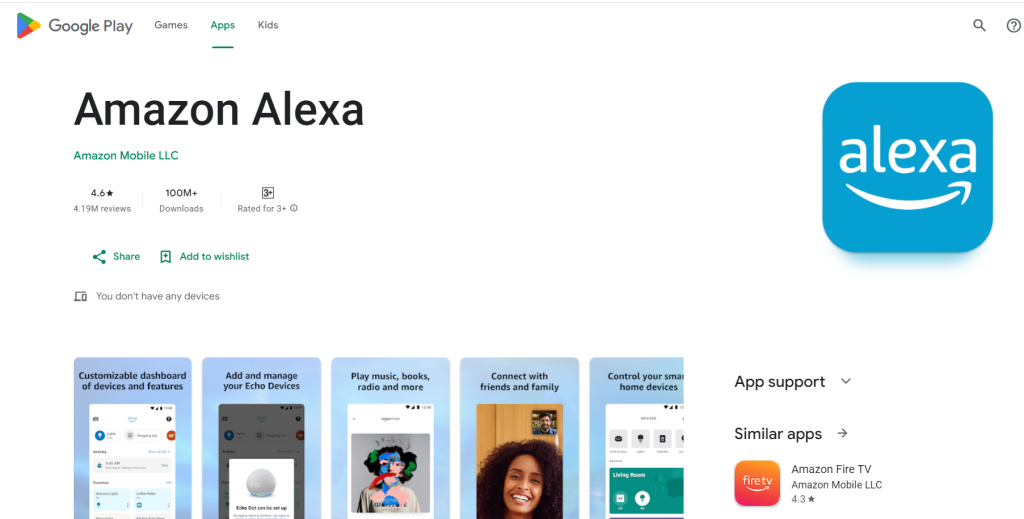
Voice Assistants in IoT Smart Homes
1 – Amazon Alexa APP
2. Google Assistant
Google Assistant is particularly famous for its close connection with Android gadgets as well as smooth compatibility with Google Home devices. It has high features of voice recognition; it can also recognize different voices and can differentiate between different commands given by different people. Google Assistant is on Number 2 Voice Assistant in Our Voice Assistants in IoT Smart Homes List
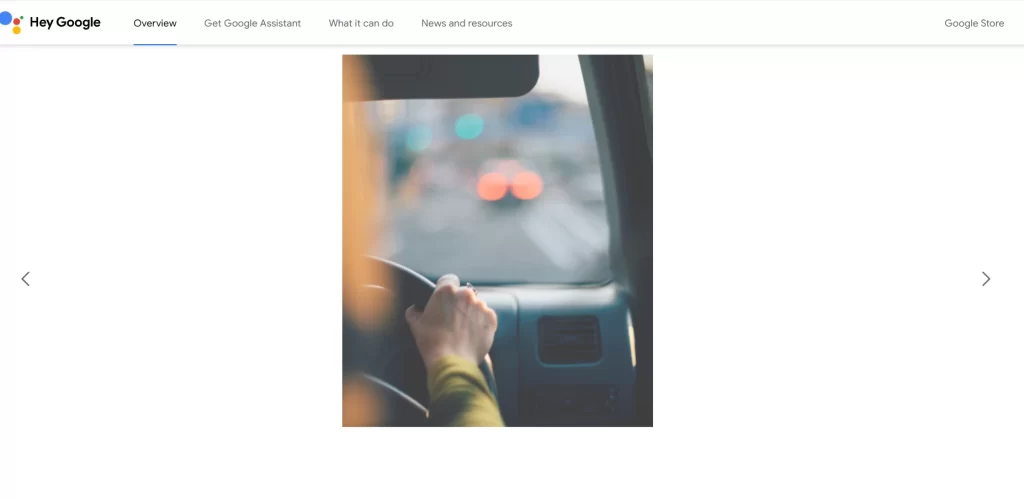
Voice Assistants in IoT Smart Homes
2 – Google Assistant
3. Apple Siri and HomeKit
Apple’s personal assistant, Siri, works with Apple’s smart home platform known as HomeKit. Although there are fewer HomeKit-compatible devices, it’s a well-protected system that focuses on user privacy, which makes it perfect for Apple users. Apple Siri and HomeKit is on Number 3 Voice Assistant in Our Voice Assistants in IoT Smart Homes List
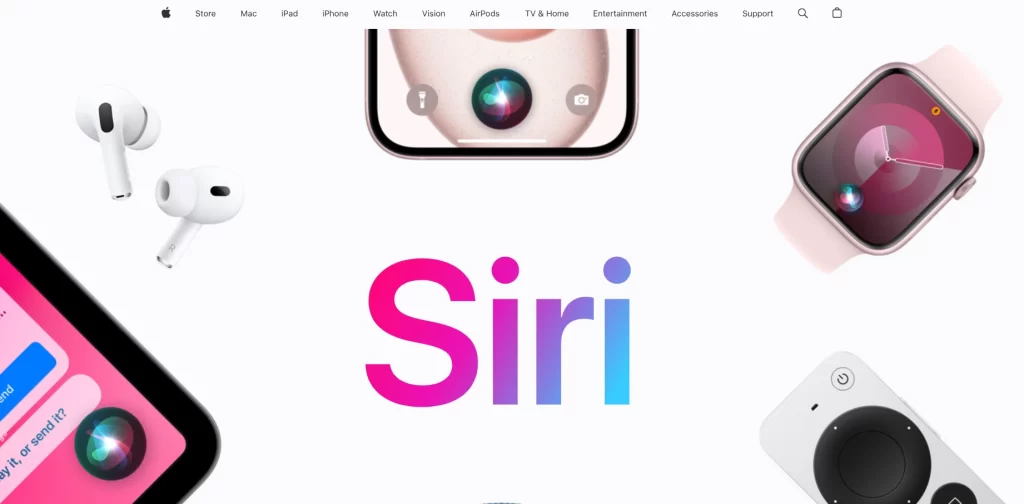
Voice Assistants in IoT Smart Homes
3- Apple Siri and HomeKit
4. Samsung Bixby and SmartThings
Samsung’s Bixby, built-in with SmartThings, assists with a vast number of IoT devices. Although the number of compatible devices is less compared to Alexa or Google Assistant, it is a smart hub for managing devices from different manufacturers. Samsung Bixby and SmartThings is on Number 4 Voice Assistant in Our Voice Assistants in IoT Smart Homes List

Voice Assistants in IoT Smart Homes
4 – Samsung Bixby and SmartThings
Characteristics of Voice Assistants in IoT Smart Homes
- Voice Control: Voice assistants make it possible to control devices with just your voice, this includes controlling things like the temperature, switching off lights or even locking doors. One can control all the smart IoT devices with voice assistants.
- Routine building: Voice assistants help create routines, which means users can schedule their daily tasks. For instance, you can create a scenario like “bedtime” that puts out the light, locks doors, and cools the room.
- Contextual Awareness: Many voice assistants can recognize individual users’ voices, allowing them to provide personalized information and responses based on user preferences.
- Real-Time Monitoring: Voice assistants can provide timely notifications and alarms. For instance, if a security camera catches any motion, Alexa or Google Assistant will alert the user with voice.
- Multilingual Support: Most popular voice assistants work with multiple languages to adapt to more users using smart home management systems.
- Compatibility and Integration: Smart assistants can be synchronized with thousands of IoT devices including locks, lighting, entertainment systems and appliances.
Security and Privacy Concerns
Data protection and security are fundamental factors when keeping or bringing a voice assistant into IoT smart homes. Here are some key aspects related to security and privacy to keep in mind:
- Data Privacy: Voice assistants capture and save commands, which could be a privacy issue. Almost all platforms provide choices to remove voice recordings regularly.
- Device Security: Most IoT devices depend on cloud services, and these are vulnerable to hacking. Choose those that have an in-built encryption and those that are frequently updated on firmware.
- Network Security: Make sure to connect to a fast, secure wireless connection and it would be safe to get a new router and dedicate a new network, especially for the IoT devices connecting to your house’s network.
Setting Up Voice Assistants with IoT Devices
Setting up voice assistants with IoT devices is typically straightforward:
- Connect your IoT devices to the application of voice assistant. For example, in the Alexa app, it is possible to include other smart devices compatible with brands such as Philips Hue and Ecobee.
- Most of the apps have features that enable users to categorize devices. Like, having all the lighting devices under “living room lights” means you can turn them on or off at once.
- Many voice assistants have routines where you can set multiple commands for one command such as “Goodnight” which turns off the lights and locks doors.
- Last of all, spend time rehearsing how to use voice commands to support the command of the devices.
Future Trends in Voice Assistants
There is a lot of potential for voice assistants in IoT smart homes of the future.
The Matter protocol is meant to become a new standard for IoT devices, to make them work better in different systems, and to let voice assistants control more devices. Personalization will be the main driver for voice assistants, as machines will be able to better identify the user’s preferences, routines and even mood. With privacy becoming a major concern in future updates, it will be possible to expect better control solutions for data storage and encryption as well as device authorization.
Possible future advancements of voice assistants might be directed towards making homeowners’ lives more environmentally friendly by advising on energy consumption.
Conclusion
Voice Assistants in IoT Smart Homes are one of the most convenient, energy-saving, and secure solutions for smart homeowners. In the future, as technology advances the use of voice-activated systems with IoT devices will modernize how people interact with their homes. Starting from Amazon Alexa and moving to Google Assistant and Apple’s Siri, each VA has its advantages in IoT smart homes. To those who are planning to enter the smart home market or shift towards the smart home market, it is very essential to have proper knowledge about the features of voice assistants, the ways to set them up, and the security issues related to voice assistants. Voice-controlled home automation systems are the future of smart living.
FAQs
Are voice assistants safe for smart homes?
Yes, but the selected devices should have good security features, and frequently updated software versions and strong passwords on Wi-Fi and device accounts should be used.
How to use voice assistants with smart things?
Prime members get basic features free of charge, but some of the other features (Alexa Guard, for instance) can be accessed only after paying a subscription fee.
Can I have two or more voice assistants in one home?
Yes it is possible to install numerous voice assistants around the house, for example, Amazon Alexa in the kitchen and Google assistant in the living room to enhance compatibility.
What distinguishes smart speakers from voice assistants?
A smart speaker is a device that contains a voice assistant (such as Echo containing Alexa). The voice assistant is the software, but the speaker is the hardware in which the software is implemented.
Which voice assistant is better to have for home security?
Most security cameras, locks and alarms are compatible with Amazon Alexa and Google Assistant. While Apple HomeKit is quite secure, it has excellent privacy settings, but there are not many security devices compatible with the system.

